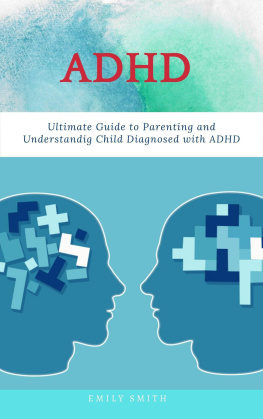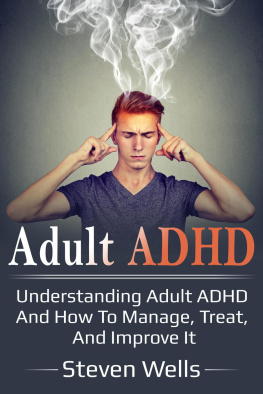The ADHD and AUTISMNUTRITIONALSUPPLEMENT
The Cutting-Edge Biomedical Approach to Treating the Underlying Deficiencies and Symptoms of ADHD and Autism
Handbook
Dana Godbout Laake, R.D.H., M.S., L.D.N., and Pamela J. Compart, M.D.
Authors of The Kid-Friendly ADHD and Autism Cookbook

In loving memory of our parents:
Ruth and Henry Compart
Dottie and Bill Beers
and
To the children and families we are privileged to serve
Who continue to be our muses and teachers.
We are humbled in your presence.
2013 Fair Winds Press
Text 2013 Dana Godbout Laake and Pamela J. Compart
First published in the USA in 2013 by
Fair Winds Press, a member of
Quayside Publishing Group
100 Cummings Center
Suite 406-L
Beverly, MA 01915-6101
www.fairwindspress.com
All rights reserved. No part of this book may be reproduced or utilized, in any form or by any means, electronic or mechanical, without prior permission in writing from the publisher.
17 16 15 14 13 1 2 3 4 5
ISBN: 978-1-59233-517-6
Digital edition published in 2013
Digital Edition: 978-1-61058-616-0
Hardcover Edition: 978-1-59233-517-6
Library of Congress Cataloging-in-Publication Data
Laake, Dana Godbout.
The ADHD and autism nutritional supplement handbook : the cutting-edge biomedical
approach to treating the underlying deficiencies and symptoms of ADHD and autism / Dana Laake and Pamela Compart, M.D.
pages cm
Includes bibliographical references and index.
ISBN 978-1-59233-517-6
1. Autism in childrenDiet therapy--Handbooks, manuals, etc. 2. Aspergers syndrome in
childrenDiet therapyHandbooks, manuals, etc. 3. Attention-deficit hyperactivity disorder
-Diet therapy--Handbooks, manuals, etc. I. Compart, Pamela J. II. Title.
RJ506.A9L317 2013
618.9285882--dc23
2012037709
Book design by Mighty Media Inc.
The information in this book is for educational purposes only. It is not intended to replace the advice of a physician or medical practitioner. Please see your health care provider before beginning any new health program.
Contents
Foreword
Nature has provided our bodies and minds with multiple pathways to preserve and enhance the function of our species. We have the capacity for rich social interactions, complex intellectual computations, and rewarding empathetic relationships. Every second in every cell of every human, simultaneous synergistic and intricate interactions facilitate our ability to function as complicated chemical, electrical, and social beings.
As a species, we have a moral imperative to protect and nurture our children. The advent of public health measures and the development of antibiotics have minimized the impact of life-threatening acute infectious illnesses, but they have failed to address the multiple environmental threats that affect the complex synergy of cellular function and increased susceptibility to chronic illness. In many of our children, we have lost the carefully orchestrated symphony that facilitates our body-mind interactions and are left with a noisy cacophony of misdirected cellular messages and disconnected neuronal pathways.
As I write these words, the American Academy of Pediatrics reports that 1 in 6 children now has a developmental, emotional, or behavioral disorder. The latest figures from the Centers for Disease Control and Prevention show that autism spectrum disorders affect 1 in 88 children in the United States (in Utah, where there are widespread screening programs, 1 in 47 children is affected). However, autism spectrum disorders affect the genders unevenly; a staggering 1 in 54 boys is diagnosed with autism in the United States. Furthermore, 54 percent of children have at least one chronic illness.
Our best evidence suggests that combinations of genetic predispositions and environmental exposures conspire to disrupt the innate mechanisms that nature has devised to protect our children. Between 300 and 800 genes are believed to be involved in the expression of autism. Environmental hazards act on the genome in various ways depending upon a specific childs genetic makeup. Although alterations to the genome, whether visible in a chromosomal karyotype or present as a mutation in a single nucleotide, have long been established as causes of disorders, gene expression has been explored more recently for physiological effects. Epigenetics, the study of chemical markers that switch genes on or off, may prove to be a fruitful field for the treatment of complex disorders. The interplay of genetic mutation and epigenetics can generate underlying metabolic, immune, inflammatory, digestive, neurological, and nutritional aberrations, which can be identified through testing and treated appropriately.
The good news is that we have specific, evidence-based strategies that utilize natures pharmacopoeia to promote the function of disrupted pathways and dysfunctional neurons. The most sophisticated treatment strategies strive to address the unique needs of each individual child from behavioral, educational, medical, metabolic, and nutritional perspectives.
Based upon the abundance of scientific research and drawing on years of experience working with children affected by developmental disorders, Dana Godbout Laake and Pamela Compart have compiled clinically valuable and specific guidelines for therapies that can change the trajectory of childrens lives. They describe clinical symptoms and physical signs common in ADHD and autism, providing detailed information about specific nutritional intervention treatment options. They present the systems, mechanisms, and nutritional biochemical science and laboratory testing that serve as the rationale for the recommendations. Also provided are extensive medical and scientific resources and references for those who seek more information.
With the publication of this book, parents and clinicians can find very specific recommendations to guide them on their quest to help a generation of children lead happier and more productive lives. The authors clearly explain why prior recommended allowances and current dietary reference intakes may not meet the nutritional demands of an individual child.
Children with developmental disorders, ADHD, and autism also live with other medical problems. These maladies cause not only physical pain, but also psychological suffering. Parents, teachers, medical practitioners, and others have seen the frustration written on a childs face as he or she yearns to communicate wants and needs, but cannot. For years I have acted upon the belief that it is a moral imperative for adults to seek therapeutic, integrative interventions. This book provides data on nutritional supplementation that can make life with these disorders better.
Elizabeth Mumper, M.D., F.A.A.P.
Advocates for Children
Advocates for Families
Rimland Center for Integrative Medicine, Lynchburg, Virginia
Former Medical Director of the Autism Research Institute
Introduction: Lets Talk About It
The journey of providing supplementation to treat symptoms of Attention Deficit Hyperactivity Disorder (ADHD) and autism may seem like driving through the country on roads devoid of signs and with no available guidebook, map, GPS, or directions. All you know is where you are. You do not know where you are supposed to be going or how to get there. Let us be your tour guides and take this journey together.
Next page







